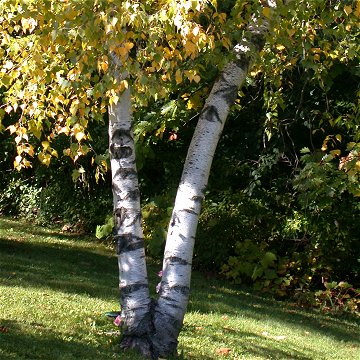

Betula populifolia - (image 1 of 4)
Taxonomy
Family: Betulaceae
Habitat
Open sites, often on sterile soils. Fire adapted.
Associates
Often with Pinus rigida on sterile sites.
Distribution
Nova Scotia west to southern Quebec, south to NJ and PA, with scattered populations to northern VA, southern Ontario, northern OH, and northern IN. Escaped from cultivation at the Morton Arboretum in northeast IL.
Morphology
Small to medium-sized tree, to 30 m. Leaves triangular, long acuminate, margin doubly serrate. Twigs slender, with warty-glandular lenticels; buds ovoid, gummy. Bark brown when young, soon becoming grayish white with little exfoliate; scars of old branches forming black triangular patches. Staminate aments solitary at the end of twigs. Fruit a cylindrical ament, spreading or ascending.
Notes
Flowers early spring
Wetland Indicator: Facultative Upland
Widely planted now as a replacement for B. papyrifera because it is more resistant to borers in warmer climates. The European weeping birch, B. pendula, is similar but with drooping twigs and diamond-shaped rather than triangular black marks on the trunk.
References
Gleason, Henry A.
and A. Cronquist. 1991. Manual of Vascular Plants of Northeastern United States
and Adjacent Canada. Second Ed.
The New York Botanical Garden. Bronx, NY
Swink, F. and G.
Wilhelm. 1994. Plants of the Chicago Region.
Indiana Academy of Science. The Morton Arboretum. Lisle, Illinois.
USDA, NRCS. 2002.
The PLANTS Database, Version 3.5 (http://plants.usda.gov).
National Plant Data Center, Baton Rouge, LA 70874-4490 USA
|
© Michael Hough 2004 |